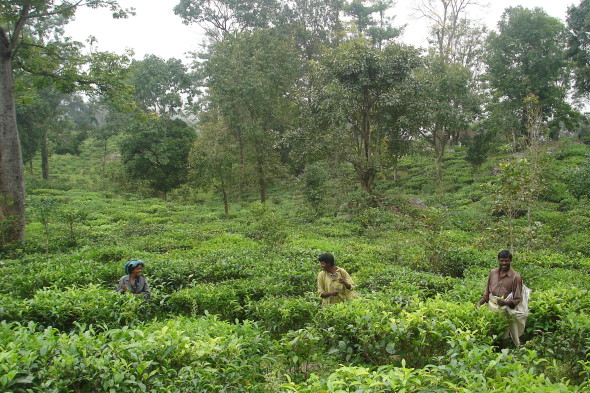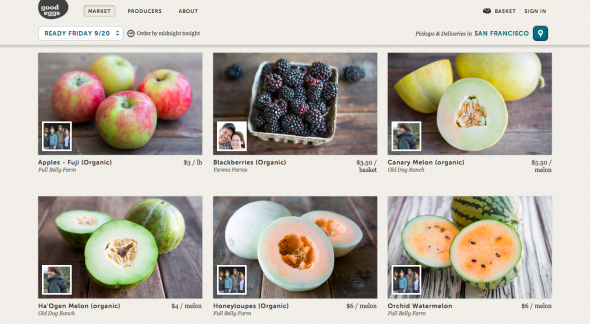The Guardian US/UK | Feb. 5, 2015

Ramesh Babu’s EcoTeas organic tea plantation in Kotagiri, Tamil Nadu, India. Photo credit: Ramesh Babu/EcoTeas
When fourth-generation tea planter Ramesh Babu decided to leave his family’s plantation in the southeast Indian state of Tamil Nadu to start his own organic operation, people called him crazy.
“It was unheard of in our part of the country,” the 54-year-old said of his decision in 2006 to take on 10 acres surrounded by forest in the hill town of Kotagiri nearby. “Initially, when you stop using [chemical] fertilizer you have a big fall in your production, so that’s one major factor which keeps other tea growers from going organic.”
Though rewarding, establishing an organic tea plantation has been challenging, Babu admits. There weren’t any other organic tea planters nearby, so he had to learn everything from vegetable farmers before launching his EcoTeas estate. And because there aren’t many small tea factories in India, he had to design his own processing machinery – a costly undertaking that took seven years. Selling the tea leaves he and his family can’t process or hand-roll on their own was also tough, Babu says, as tea companies pay the same going rate for organic leaves as for conventionally produced leaves.
It’s a lonely road that has left the family-run operation in the red to this day, but it could be an important one. A Greenpeace India report – which has been challenged as “pseudo-scientific” by the tea industry – released in August found that more than 90 percent of the domestic packaged and produced tea contained pesticide residues (pdf).
Yet despite the roadblocks, organic tea production could be moving closer to the norm in a country that produces more tea than any other except China. In the past few months, the two largest tea companies in India – Tata Global Beverages and Hindustan Unilever, which together comprise over 50 percent of the domestic market – announced it would set up pilot studies with the government to test how their growers can phase out pesticide use.
In a statement, Hindustan Unilever said it plans to work with nonprofit agricultural advisor Cabi on the feasibility study and source all of its agricultural raw materials using sustainable crop practices by 2020. The company aims to launch the pilot in April, according to Greenpeace India campaigner Neha Saigal, but it’s not clear when Tata – the second largest tea company in the world (hit in recent years with reports that female workers had been trafficked into domestic slavery from a plantation in Assam) – plans to kick off its program, which also has a goal to achieve sustainable sourcing by 2020.
More details about the pilots aren’t clear, as the companies have remained tight-lipped. (Both declined to comment). But when the largest players in any industry take their first steps towards sustainability, it raises the question: could this pave the way for smaller producers to shift to organic cultivation too?
There’s a huge need to bring down barriers that make it harder for growers to go organic, according to Saigal, whose organization pushed for the pesticide-free commitment, and is now keeping an eye on the companies to implement the pilots. India’s regulations for pesticide use in tea aren’t straightforward or consistent from one jurisdiction to another, nor comprehensive, she says.
“Pesticide regulation in India is in shambles,” Saigal said. “What this shows is that you need a policy level change.”
“Growers aren’t aware of what they are using and what they aren’t using,” she added. “It’s the government’s job to make these small growers aware of what’s toxic and what’s not. It’s their job to create those support systems creating a knowledge base and having a system to transform that knowledge to use ecological alternatives.”
Greenpeace India is in talks with the Tea Board of India – the government-run body with the authority to crack down on these regulatory problems – about setting up a support system for small tea growers so they can move away from pesticides.
In September, the Tea Board (which did not respond to interview requests) issued the second version of its Plant Protection Code that listed the approximately three dozen pesticides approved for use in tea. Yet maximum residue levels had been set for just 10 of them, according to the document.
Government support is needed for organic tea production to thrive in India, Babu says.
“The government of India and the Tea Board have got to come up with a very supportive package for small tea growers,” he said. “This would mean giving subsidies to help small tea growers convert to organic.”

In direct opposition to the monoculture standard, Babu has not removed the trees that have taken root throughout his EcoTeas plantation. Photo credit: Ramesh Babu/EcoTeas
Babu has his own plan to jumpstart a new generation of organic tea growers in India. He expects his factory to be fully up and running in the next few months, which he believes will improve his financial position, since he’ll be able to produce up to 30 times more tea. Once that happens, he wants to teach other growers how convert to organic growing so he can process their leaves in his factory and start an organic growers association that could foster mutual support and push for higher payments for their leaves.
But Hope Lee, a business analyst who specializes in the hot beverages market for intelligence research firm Euromonitor International, says that small tea growers in India and other developing markets – such as Argentina, the Middle East, China and Kenya – face other challenges beyond their borders.
“They find it hard to export their product to developed markets because they don’t meet strict standards in developed countries,” she said. “Some companies in developing countries don’t have money to hire these expensive services [to test for pesticide levels] and they don’t see the short-term profit from it if they pay a lot of money for testing.”
But it also depends on how serious the national government is in promoting their tea exporting business and how they set their standards, she added.
“So this issue comes to the question [of] if Unilever or Tata have the resources to solve this problem,” Lee said. “Big companies like Twinings or Unilever or Tata – they can influence the government and they have the resources to train their suppliers and make their tea grow in a more sustainable way, but they need the cooperation of the local government,” she said.
Fair-trade and certification programs are used as additional strategies to move industries towards more sustainable practices. Yet Daan de Vries, the markets director at UTZ Certified, an Amsterdam-based organization, says that certification alone is not enough.
“In some places there’s value but it’s not the way to go to change markets,” he said. “Consistently, you’ll see no more than maybe 5% of people who would want to change their buying behavior based on sustainability claims or labels.”
Tea 2030 is an initiative that appears to be taking on a more comprehensive approach. Organized by UK-based nonprofit Forum for the Future, industry heavyweights like Unilever, Tata and Twinings have joined with the Ethical Tea Partnership, Fairtrade and Rainforest Alliance to identify challenges facing the tea industry, such as competition for land, climate change, natural resource constraints and living wage issues. (Starbucks also joined late last year).
A report released by the initiative last year lays out these challenges, along with principles for a sustainable value chain, which the alliance would like to see in action by 2030.
“Of course the individual companies are pursuing their own sustainability [initiatives], such as Unilever and Tata on pesticides,” said Ann-Marie Brouder, Tea 2030’s coordinator. “But there are some problems too big for individual companies to tackle…. We believe that if we’re going to make change, it needs to be owned by the tea sector.”
In the meantime, Babu continues to quietly push forward, all the while tending his tea plants and the trees he’s allowed to intersperse among the crop in direct opposition to the monoculture plantation standard.
“It’s something that cannot be approached in terms of a business,” he said. “It’s a change of the mindset.”
View the original story here.






